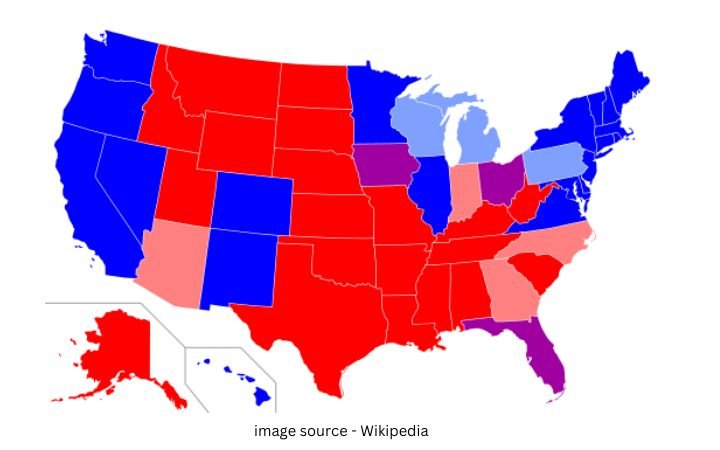Understanding the U.S. Electoral Map: Blue, Red, and Swing States in the 2024 Presidential Election
As the United States gears up for the 2024 presidential election, terms like “blue states,” “red states,” and “swing states” are at the forefront of political discussions. These labels reflect the country’s partisan divide, shaping how candidates allocate time, resources, and strategic efforts. Understanding these distinctions and the trends within them offers insights into how American elections operate and which states are expected to play decisive roles in determining the next president.
What Are Blue and Red States?
In U.S. politics, “red states” lean Republican, whereas “blue states” lean Democratic. This color-coded language, popularized during the 2000 presidential election, provides a simplified view of each state’s political leanings.
Blue States
Traditionally, states like California, New York, and Illinois are considered blue. These areas often support progressive policies, prioritize social justice, and have urban centers that drive their political agendas. The Democratic Party’s appeal in these states is often anchored in a focus on social welfare, healthcare access, environmental protection, and support for diversity.
Red States
Conversely, states like Texas, Alabama, and Wyoming are classified as red. These states typically emphasize conservative values, individual liberties, limited government, and a preference for traditional social structures. Rural and suburban populations, which form a significant portion of red states’ demographics, often favor the Republican Party’s positions on taxation, Second Amendment rights, and national security.
Electoral College and Its Impact on Campaign Strategy
Unlike other democracies, the United States does not determine its presidential election through a simple national popular vote. Instead, each state holds an election, and its electoral college votes—allocated based on population—are awarded to the candidate who wins the majority in that state. For example, populous California has 54 electoral votes, while sparsely populated Wyoming has just three. This system shifts campaign strategies toward securing victories state by state.
In highly populated blue states, the Democratic Party usually has an edge, while the Republican Party relies on wins in red states. But swing states, also known as battleground states, are where the contest becomes fierce. These states do not consistently vote for one party and are therefore targeted with the most time, funding, and resources, as they can tilt the scales toward either candidate.
Swing States: The Battlegrounds of U.S. Politics
Swing states vary in their political leanings from one election to the next, making them highly sought-after prizes in the race to 270 electoral votes. Often described as “purple” states because they can lean either Democratic or Republican, swing states have a mixed voter base and shifting political sentiments that make them unpredictable.
Examples of Swing States
States such as Florida, Pennsylvania, Michigan, Wisconsin, Arizona, and Georgia are notable swing states. These states are often in the spotlight due to their considerable number of electoral votes and their fluctuating partisan loyalties.
Campaign Focus
In these states, candidates from both parties focus heavily on addressing issues that resonate with undecided or swing voters. For instance, economic policies, healthcare reforms, immigration, and education are some of the recurring topics in campaign speeches, advertisements, and debates.
How Trends in Voting Shape the Political Map
The 2020 presidential election highlighted several emerging trends that analysts expect to continue influencing the 2024 race. The divide between blue and red states remains pronounced, but recent shifts indicate changes that could affect the overall electoral landscape.
Demographic Changes
An increase in younger, diverse populations in states like Arizona, Georgia, and Texas has led to changes in voting patterns. Younger voters and individuals from minority backgrounds often lean Democratic, contributing to the shifting political allegiances in these traditionally red states.
Suburban Shifts
As suburban areas grow and become more demographically diverse, they have become political battlegrounds. In the past, suburban areas were more reliably conservative, but recent elections have shown a shift toward Democratic candidates. For instance, suburban voters in states like Georgia helped Joe Biden secure a win in 2020.
Economic Issues and Social Policies
Key issues such as economic recovery, healthcare costs, and climate change continue to drive voting behavior. Red states may emphasize issues like inflation, job security, and personal freedoms, while blue states tend to focus on environmental protection, social justice, and healthcare expansion. Swing states often mirror national concerns, making them unpredictable yet critical in presidential elections.
The Senate and House of Representatives’ Functions
The partisan divide also influences elections for Congress, particularly in the House of Representatives, where seats are allocated based on population. Consequently, populous states have more influence, attracting greater attention from candidates in congressional races.
Senate Elections
Every state, regardless of population, has two seats in the U.S. Senate. This balance allows smaller states to maintain representation equal to more populous ones, giving red states with smaller populations a solid Senate representation.
House Elections
Conversely, the House of Representatives bases its allocation of seats on state populations. States like California, Texas, and Florida thus wield greater influence. This structure shapes campaign efforts, with candidates in populous states making promises tailored to the diverse needs of larger populations.
Shifting Alliances and the Importance of the 2024 Election
The 2024 presidential election may further reshape the landscape between blue, red, and swing states. Candidates are mindful of shifting alliances and growing issues that may redefine long-standing partisan loyalties.
Arizona and Georgia
These two states, which flipped blue in the 2020 election, remain focal points. With increasing suburban populations and growing diversity, these states’ political allegiances are being tested as they adjust to demographic and economic changes.
Blue States Facing Challenges
In traditionally blue states, issues like crime, taxation, and housing affordability have created tension, potentially leading some voters to reconsider their allegiance. For example, California and New York face criticism for high taxes and rising costs of living, which could affect voter sentiment.
Republican Strongholds Adapting to Change
In states like Texas, demographic shifts and growing urban populations are changing the political landscape. While Texas has long been a reliable red state, its urban centers are increasingly blue-leaning, making it a potential swing state in future elections.
Conclusion: The Evolving Electoral Landscape
The U.S. electoral map is dynamic, with blue, red, and swing states offering distinct challenges and opportunities for presidential candidates. While blue states provide Democrats with strongholds and red states reinforce Republican bases, swing states remain the focal point of the campaign due to their unpredictability. As America approaches the 2024 presidential election, candidates are keenly aware of the importance of these battlegrounds, where shifting demographics and evolving priorities could influence the nation’s next leader. This ever-changing map underscores the importance of understanding the unique political fabric of each state, as well as the issues that matter most to its residents.










